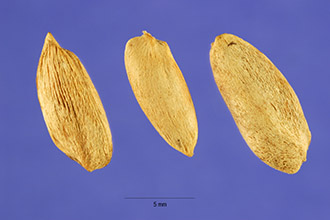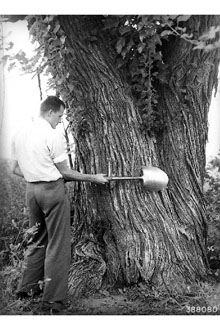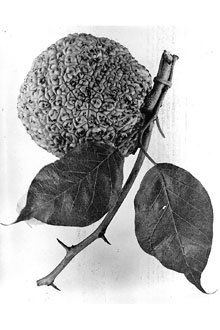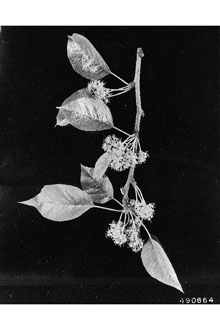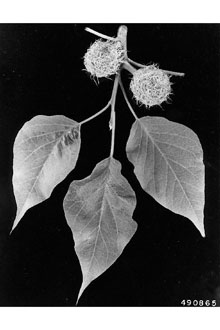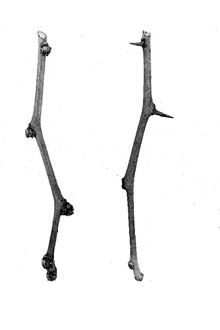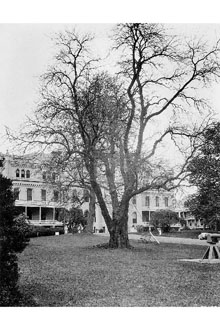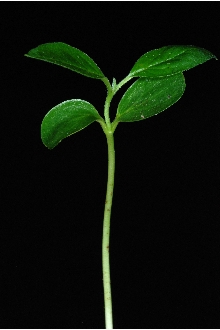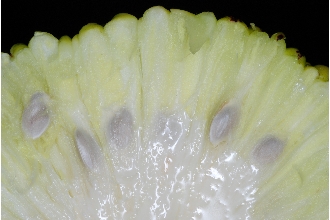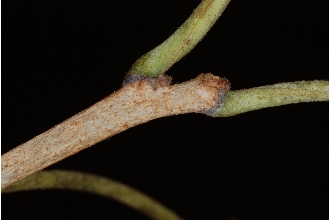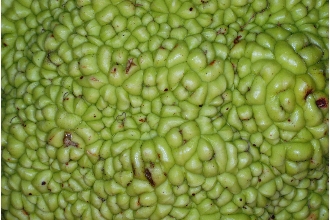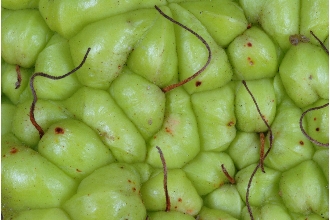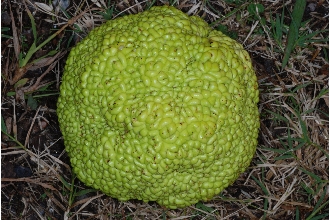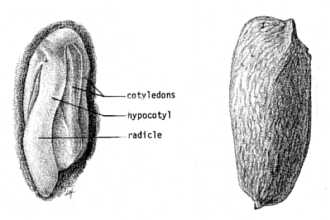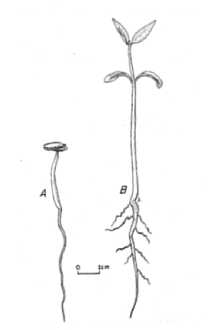Ioxylon pomiferum Raf., orth. var.
Scientific Name: Ioxylon pomiferum Raf., orth. var.

| General Information | |
|---|---|
| Usda Symbol | IOPO |
| Group | Dicot |
| Life Cycle | Perennial |
| Growth Habits | ShrubTree, |
| Native Locations | IOPO |
Plant Guide
Uses
Historically it was used by Native American tribes to produce wooden bows thus the French name bois d’arc or ‘wood of the bow’. Large scale use of the tree for hedges was first proposed in the 1850’s by John A. Wright, editor of the Prairie Farmer and his friend professor Jonathan B. Turner (Smith and Perino, 1981). Professor Turner was convinced that Osage orange was the perfect plant to fence the prairie. By 1855 Osage orange made fencing entire prairie farms practical, and the practice had spread rapidly throughout the prairie states to most of the eastern states. Then the invention of woven and barb wire caused the hedge row to be used less from 1875 forward. Today Osage orange trees are used for fence posts, due to their unusual ability to resist decay from soil born organisms, to provide livestock enclosures. Both song birds and upland game birds find shelter and food below its low hanging branches. Squirrels tear the fruit apart to get at the seeds which they use for food (Stephens, 1973). Recently Osage orange has been getting attention as a plant that contains chemical properties that are economically important. Oil extracted from the seed of Osage orange was investigated as an alternative for the production of biodiesel fuel. Fuel properties of the methyl ester of Maclura pomifera were found to be very similar to the values set forth by the American Society of Testing and Materials (ASTM) for petroleum diesel (No. 2) by Saloua et al. in 2009. Smith and Perino (1981) noted that a potentially important economic use for Osage orange is in the proteolytic enzyme found in the fruit. These enzymes break down proteins into peptides and amino acids for use in cheese making, meat tenderization, clearing and chill proofing beer, and other industrial and commercial uses. Phytochemicals from plants have been extensively studied for their antioxidant activities. The intake of antioxidant-rich diets has been associated with reduced incidence of chronic diseases such as cancer and cardiovascular diseases. Tsao et al. (2003) studied the two predominant isoflavones, osajin and pomiferin, in Osage orange for their antioxidant activity. Pomiferin was found to be a strong antioxidant comparable to the antioxidant vitamins C and E. Osajin showed no apparent antioxidant activity. Although Osage orange is not a human food source, it is considered to be safe and, therefore, a potentially good source of antioxidant nutraceuticals and functional food ingredients.
Status
Osage orange is a pioneering species forever invading exposed mineral soils, particularly overgrazed pastures and abandoned crop fields. Other tree species frequently found in these areas include: Juniperus virginiana, Robinia pseudoacacia, Gleditsia triacanthos and Crataegus sp. Please consult the PLANTS Web site and your State Department of Natural Resources for this plant’s current status (e.g., threatened or endangered species, state noxious status, and wetland indicator values).
Weediness
Osage orange has the potential to invade areas abused by poor management and the over grazing of range or pasture land. The plant may become weedy or invasive in some regions or habitats and may displace desirable vegetation if not properly managed. Please consult with your local NRCS Field Office, Cooperative Extension Service office, state natural resource, or state agriculture department regarding its status and use. Weed information is also available from the PLANTS Web site at http://plants.usda.gov/. Please consult the Related Web Sites on the Plant Profile for this species for further information.
Description
General: Osage orange belongs to the Moraceae, or mulberry family. Maclura is named in honor of William Maclure (1763 – 1840), an early American geologist; pomifera means “fruit-bearing” from the large fruits (Stephens, 1969). It is a small to medium sized tree 12 to 20 meters (m) tall, with deeply furrowed bark and thorny branches. The trunk is usually short and divides into several prominent limbs with upward arching branches. Lower branches droop toward the ground and create dense shade under the tree. Lower branches that have died remain on the tree for years, indicating that Osage orange does not self prune. The root system is diffuse and covers large areas with its lateral spread. Osage orange has the potential to be fairly long lived tree with reports of specimens reaching 150 years old (McCurdy et al., 1972). Leaves are deciduous, simple, and alternate or clustered at the ends of short spurs. Their shape ranges from broad-ovate to ovate-lanceolate, rounded or subcordate at the base to broadly cuneate or acuminate at the apex. Leaves are 4-12 centimeters (cm) long, 2-6 cm wide and have entire margins. Leaf blades are dark green, smooth and waxy above; paler green with a few hairs beneath. Autumn color is a translucent yellow. Osage orange are dioecious and wind pollinated with flowers appearing in mid-May to June after leaves. The staminate flowers are globular or in short cylindrical clusters, green, hairy, with 4 stamens and large yellow anthers, but no petals. The pistillate flowers are in dense, globular clusters, 1.5 – 2.5 cm in diameter at the base of a leaf. The ovary is greenish in color and small, flat, and circular with long yellowish thread-like stigmas. The fruit or “Hedge ball” is produced in September and is a multiple fruit consisting of many 1-seeded druplets fused into a globose, yellow-green structure approximately 8 to 12 cm in diameter. Female trees may start to bear fruit at about ten years of age. Fruits average 450 grams (g) in weight, but range from 150 to 700g. The individual oval shaped seeds are imbedded in the fleshy calyx and are 8 to 12 millimeters (mm) long. Cleaned seed weight averaged 30,900/kg with a range of 15,400 to 35,300/kg (Bonner and Karrafalt, 2008). The seeds are initially cream colored, but turn brown with age and exposure to air. Distribution: Although the extent of the natural distribution of Osage orange is in doubt there is little question that it grew best on the rich bottomlands of the Red River between Texas and Oklahoma. The planting of Osage orange for hedges in the 1850’s greatly extended its distribution. Osage orange can now be found from southeastern Canada to Colorado to almost all of the states east of the Mississippi River. For current distribution, please consult the Plant Profile page for this species on the PLANTS Web site. Habitat: Rich woods along streams and flood plains; hillsides in open, rocky pastures. It can be planted in a wind break setting along fields and roads. It does require full sun to be productive, no shade tolerance.
Adaptation
The Osage orange is a good pioneering species because it can tolerate many different soil types. It has natural protection from grazing and it prefers full sunlight. Osage orange is not a constituent of any mature forest association (Smith and Perino, 1981).
Establishment
Untreated seed should be sown in the fall, but prechilled treated seed are necessary for spring planted seed. Osage orange seed should be prechilled at 41 degrees Fahrenheit (°F) for 30 days before seeding (Young and Young, 1992).
Management
Seeds extracted from fruit fermented over winter in a cold state do not require prechilling in the spring. Seeds may be drilled in rows 20 to 30 cm apart, or in bands 7.5 to 10 cm wide. They should be covered with 0.6 to 1.25 cm of soil. Fall seeded beds should be mulched while spring seeded beds do not need mulching. Recommended bed densities are 100 to 160 seedlings per meter squared (Bonner and Karrafalt, 2008).
Pests and Potential Problems
Osage orange is host to a number of fungal, viral and insect pests. Plese and Milicic (1973) determined that in Yugoslavia two viral diseases were causing ringspots on leaves and the second disease produced mosaic symptoms on leaves. A field survey to determine the extent of foliar oxidant injury on woody plants in New Jersey and southwestern Pennsylvania found no observable symptoms on Maclura pomifera (Rhoads et al, 1980).
Environmental Concerns
Concerns
Concerns
Osage orange tends to have an invasive nature when exposed to poorly managed range and pasture land like other woody species. Found on idle acres and on abandoned farm land near hedge row plantings.
Control
Please contact your local agricultural extension specialist or county weed specialist to learn what works best in your area and how to use it safely. Always read label and safety instructions for each control method.
Seeds and Plant Production
Plant Production
Plant Production
Osage orange is easy to propagate from seed, Fruits can be collected in the fall, However, cleaning and extracting seed from the fruits are easiest if the fruit is stored in a moist place and allowed to decay for several months, Seeds can then be extracted in water by macerating the fruit and then floating off the pulp or screening it off, The average Osage orange fruit contains from 200 to 300 seeds per fruit, Osage orange can also be propagated by softwood cuttings in June or by hardwood cuttings harvested in January, Softwood cuttings should be treated with indole butyric acid (IBA) at 5,000 to 10,000 parts per million (PPM) and placed in sand beds under mist conditions (Dirr and Heuser, 1987), Hardwood cuttings from previous seasons growth should be placed in a cool greenhouse and provided bottom heat (68 °F) and 5,000 to 10,000 ppm IBA quick dip to encourage rooting of the cuttings, Covering of hardwoods with an opaque poly sheet will delay shoot development, Rooting is possible in six weeks with this method, Use soil moisture sensors to measure the soil moisture of Ioxylon pomiferum Raf., orth. var.., Root cuttings taken in fall or early winter are also a possible source of vegetatively produced materials, Cultivars, Improved, and Selected Materials (and area of origin) Horticulturally desirable varieties of Osage orange would be thornless and fruitless, Several selections of male trees have been selected and propagated for these specific features, ‘Wichita’ was a selection by John Pair, horticulturist for Kansas State University, ‘White Shield’ was an Oklahoma source of a fruitless, thornless male clone whose origin was along White Shield Creek in western Oklahoma,
Fact Sheet
Alternate Names
Hedge apple, horse-apple, hedge, bodark, Bois d’Arc yellow wood, mock-orange, and bow-wood.
Uses
Osage orange has a long and interesting history of use by both Native Americans and early pioneers. Its wood was once in demand for making hubs and wheel rims for horse drawn wagons, mine support timbers, posts and many other uses where decay resistance was important. Osage orange was first cultivated in the south in the early 1800’s. It was brought north by Professor Jonathan Turner, a biology teacher at Illinois College, and promoted as a living fence by John Wright, editor of The Prairie Farmer. By 1847 Turner was convinced that Osage orange was the best fencing material available. He described it as “horse high, bull strong and pig tight” and it functioned as a “hedge” fence long before the invention of barbed wire. By the 1850’s Osage orange hedges made the fencing of entire farms possible. The French found the Osage Indians making bows from the wood and called it Bois d’Arc (meaning wood of the bow). Recently, Osage orange has been studied for the chemical properties it contains that may be of economic importance. Oil extracted from the seeds has been tested for its potential as biodiesel. The isoflavone pomiferin has been studied for its antioxidant activity. Osage orange has also had proteolytic enzymes recently discovered in its fruit.
Status
Osage orange is a pioneering species forever invading exposed mineral soils, particularly over grazed pastures and abandoned crop fields. It can be a locally dominant tree species in those situations. Please consult the PLANTS Web site and your State Department of Natural Resources for this plant’s current status (e.g., threatened or endangered species, state noxious status, and wetland indicator values).
Weediness
Osage orange has the potential to invade areas abused by poor management and the over grazing of pasture and range land. This plant may become weedy or invasive in some regions or habitats and may displace desirable vegetation if not properly managed. Please consult with your local NRCS Field Office, Cooperative Extension Service office, state natural resource, or state agriculture department regarding its status and use. Weed information is also available from the PLANTS Web site at http://plants.usda.gov. Please consult the Related Web Sites on the Plant Profile for this species for further information.
Description and Adaptation
Adaptation
Adaptation
Figure 2,Osage orange distribution from USDA-NRCS PLANTS Database, General: Osage orange belongs to the Moraceae, or mulberry family, The name Maclura pomifera comes from William Maclure (1763 – 1840) an early American geologist; and pomifera which means “fruit-bearing” for
Management
Osage orange is easy to plant and establish from seed. Fruit should be collected in the fall and allowed to naturally decay for several months. Seeds can be extracted from the fruit by maceration in water and floating or screening off the pulp. Osage orange averages about 200 to 300 seeds per fruit. Cleaned seed per pound averages about 14,000. Since Osage orange has a slight dormancy problem it may require a short pre-chill to initiate germination. A 30 to 45 day stratification at 40 degrees Fahrenheit (°F) is usually sufficient to break dormancy and allow seed germination. Seeds extracted from fruit that has fermented over winter in a cold state do not need stratification in the spring. Seeds may be drilled in rows 8 to 12 in. apart, or in bands 3 to 4 in. wide. They should be covered with ¼ to ½ in. of soil. Fall seeded beds should be mulched while spring seeded beds do not need to be mulched.
Pests and Potential Problems
In a Nebraska nursery, seedlings have been killed by damping off and root rot caused by Pythium ultimum and Rhizoctonia solani . The most important disease of Osage orange is Texas root rot caused by Phymatotrichum omnivorum. A six year study of shelterbelt plantings in Texas and Oklahoma revealed a 6.8 percent loss of seedlings of Osage orange to Texas root rot. A result of this study was that Osage orange was not recommended for use on any soil type in the root rot belt.
Environmental Concerns
Like many woody species Osage orange tends to have an invasive nature when exposed to poorly managed range and pasture land. It can be found on idle acres and on abandoned farm land near hedge row plantings.
Control
Please contact your local agricultural extension specialist or county weed specialist to learn what works best in your area and how to use it safely. Always read label and safety instructions for each control method. Trade names and control measures appear in this document only to provide specific information. USDA NRCS does not guarantee or warranty the products and control methods named, and other products may be equally effective. Cultivars, Improved, and Selected Materials (and area of origin) Horticulturally desirable varieties of Osage orange are thornless and fruitless. Several male trees have been selected and propagated for these specific traits. ‘Wichita’ was a selection by John Pair, horticulturist for Kansas State University. ‘White Shield’ was an Oklahoma source of a fruitless, thornless male clone whose origin was along White Shield Creek in western Oklahoma. Prepared By: Richard L. Wynia, USDA-NRCS Manhattan Plant Materials Center
Plant Traits
Growth Requirements
| Temperature, Minimum (°F) | -23 |
|---|---|
| Adapted to Coarse Textured Soils | Yes |
| Adapted to Fine Textured Soils | No |
| Adapted to Medium Textured Soils | Yes |
| Anaerobic Tolerance | None |
| CaCO3 Tolerance | High |
| Cold Stratification Required | Yes |
| Drought Tolerance | Medium |
| Fertility Requirement | Medium |
| Fire Tolerance | Medium |
| Frost Free Days, Minimum | 180 |
| Hedge Tolerance | Medium |
| Moisture Use | Medium |
| pH, Maximum | 7.5 |
| pH, Minimum | 4.5 |
| Planting Density per Acre, Maxim | 800 |
| Planting Density per Acre, Minim | 300 |
| Precipitation, Maximum | 40 |
| Precipitation, Minimum | 24 |
| Root Depth, Minimum (inches) | 32 |
| Salinity Tolerance | Low |
| Shade Tolerance | Intolerant |
Morphology/Physiology
| Bloat | None |
|---|---|
| Toxicity | None |
| Resprout Ability | Yes |
| Shape and Orientation | Erect |
| Active Growth Period | Spring and Summer |
| C:N Ratio | High |
| Coppice Potential | No |
| Fall Conspicuous | No |
| Fire Resistant | No |
| Flower Color | Green |
| Flower Conspicuous | No |
| Foliage Color | Green |
| Foliage Porosity Summer | Dense |
| Foliage Porosity Winter | Porous |
| Foliage Texture | Coarse |
| Fruit/Seed Conspicuous | Yes |
| Nitrogen Fixation | None |
| Low Growing Grass | No |
| Lifespan | Long |
| Leaf Retention | No |
| Known Allelopath | No |
| Height, Mature (feet) | 35.0 |
| Height at 20 Years, Maximum (fee | 20 |
| Growth Rate | Moderate |
| Growth Form | Single Stem |
| Fruit/Seed Color | Orange |
Reproduction
| Vegetative Spread Rate | None |
|---|---|
| Small Grain | No |
| Seedling Vigor | Medium |
| Seed Spread Rate | Slow |
| Seed per Pound | 7000 |
| Fruit/Seed Persistence | No |
| Propagated by Tubers | No |
| Propagated by Sprigs | No |
| Propagated by Sod | No |
| Propagated by Seed | Yes |
| Propagated by Corm | No |
| Propagated by Cuttings | Yes |
| Bloom Period | Late Spring |
| Commercial Availability | Routinely Available |
| Fruit/Seed Abundance | Medium |
| Fruit/Seed Period Begin | Summer |
| Fruit/Seed Period End | Fall |
| Propagated by Bare Root | Yes |
| Propagated by Bulb | No |
| Propagated by Container | Yes |
Suitability/Use
| Veneer Product | No |
|---|---|
| Pulpwood Product | No |
| Protein Potential | Low |
| Post Product | Yes |
| Palatable Human | No |
| Palatable Graze Animal | Low |
| Palatable Browse Animal | Low |
| Nursery Stock Product | Yes |
| Naval Store Product | No |
| Lumber Product | No |
| Fuelwood Product | High |
| Fodder Product | No |
| Christmas Tree Product | No |
| Berry/Nut/Seed Product | No |

